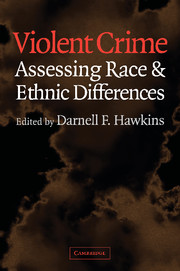Book contents
- Frontmatter
- Contents
- Contributors
- Foreword
- Editor's Introduction
- Violent Crime
- Part I Homicide Studies
- 1 Homicide Risk and Level of Victimization in Two Concentrated Poverty Enclaves: A Black/Hispanic Comparison
- 2 Moving Beyond Black and White Violence: African American, Haitian, and Latino Homicides in Miami
- 3 Homicide in Los Angeles County: A Study of Latino Victimization
- 4 Economic Correlates of Racial and Ethnic Disparity in Homicide: Houston, 1945–1994
- 5 The Race/Ethnicity and Poverty Nexus of Violent Crime: Reconciling Differences in Chicago's Community Area Homicide Rates
- Part II Other Contexts, Settings, and Forms of Violence
- Part III Explaining Racial and Ethnic Differences
- References
- Index
5 - The Race/Ethnicity and Poverty Nexus of Violent Crime: Reconciling Differences in Chicago's Community Area Homicide Rates
Published online by Cambridge University Press: 22 August 2009
- Frontmatter
- Contents
- Contributors
- Foreword
- Editor's Introduction
- Violent Crime
- Part I Homicide Studies
- 1 Homicide Risk and Level of Victimization in Two Concentrated Poverty Enclaves: A Black/Hispanic Comparison
- 2 Moving Beyond Black and White Violence: African American, Haitian, and Latino Homicides in Miami
- 3 Homicide in Los Angeles County: A Study of Latino Victimization
- 4 Economic Correlates of Racial and Ethnic Disparity in Homicide: Houston, 1945–1994
- 5 The Race/Ethnicity and Poverty Nexus of Violent Crime: Reconciling Differences in Chicago's Community Area Homicide Rates
- Part II Other Contexts, Settings, and Forms of Violence
- Part III Explaining Racial and Ethnic Differences
- References
- Index
Summary
Introduction
Research on the relationship among race, poverty, and violent crime has a long tradition that is grounded in theoretical and empirical sociological literatures aimed largely at explaining the geographic and spatial distribution of violence (Wolfgang and Ferracuti, 1967; Beasley and Antunes, 1974; Loftin and Hill, 1974; Mlandenka and Hill, 1976; Anderson, 1999). One of the earliest theoretical perspectives suggested that the highest rates of violence are found in poor communities in which oppositional subcultures promote public displays of toughness and fatalism among residents (Wolfgang, 1967). These communities are typically described as neighborhoods with large ethnic or racial minority populations and places where residents are resentful and frustrated by their lack of economic opportunity and social isolation (Blau and Blau, 1982; Messner, 1983; Logan and Messner, 1987; Peterson and Krivo, 1993). Violence is considered a manifestation of feelings of diffused anger, resentment, and frustration, all of which are closely associated with economic disadvantage (Phillips, 1997). When the anger and frustration is not well managed, violence is just one of many outcomes (e.g., see Messner, 1983, for a similar discussion on hostility and aggression; Harer and Steffensmeier, 1992; Hsieh and Pugh, 1993). Proponents of this perspective posit that the association between racial/ethnic composition and criminal violence attenuates as stressors like resource deprivation and inequality are alleviated (Block, 1979; Messner, 1982; Williams, 1984; Sampson, 1985; 1986; Messner and Tardiff, 1986).
- Type
- Chapter
- Information
- Violent CrimeAssessing Race and Ethnic Differences, pp. 89 - 114Publisher: Cambridge University PressPrint publication year: 2003



